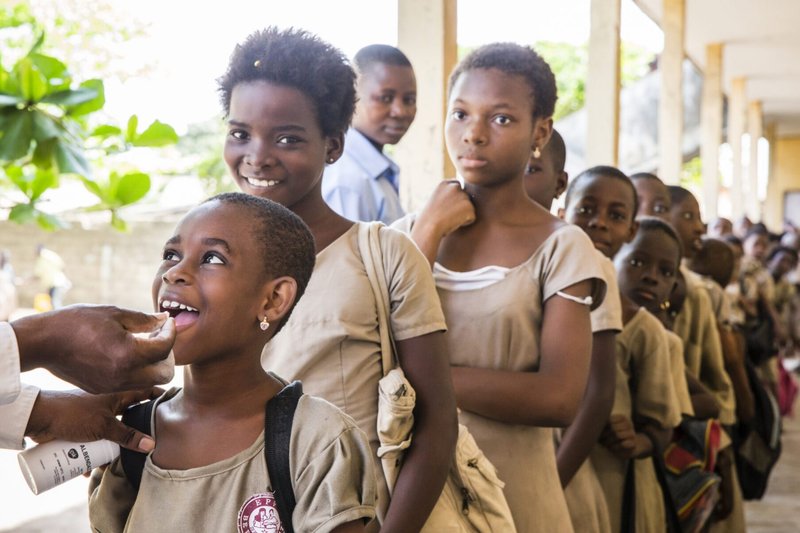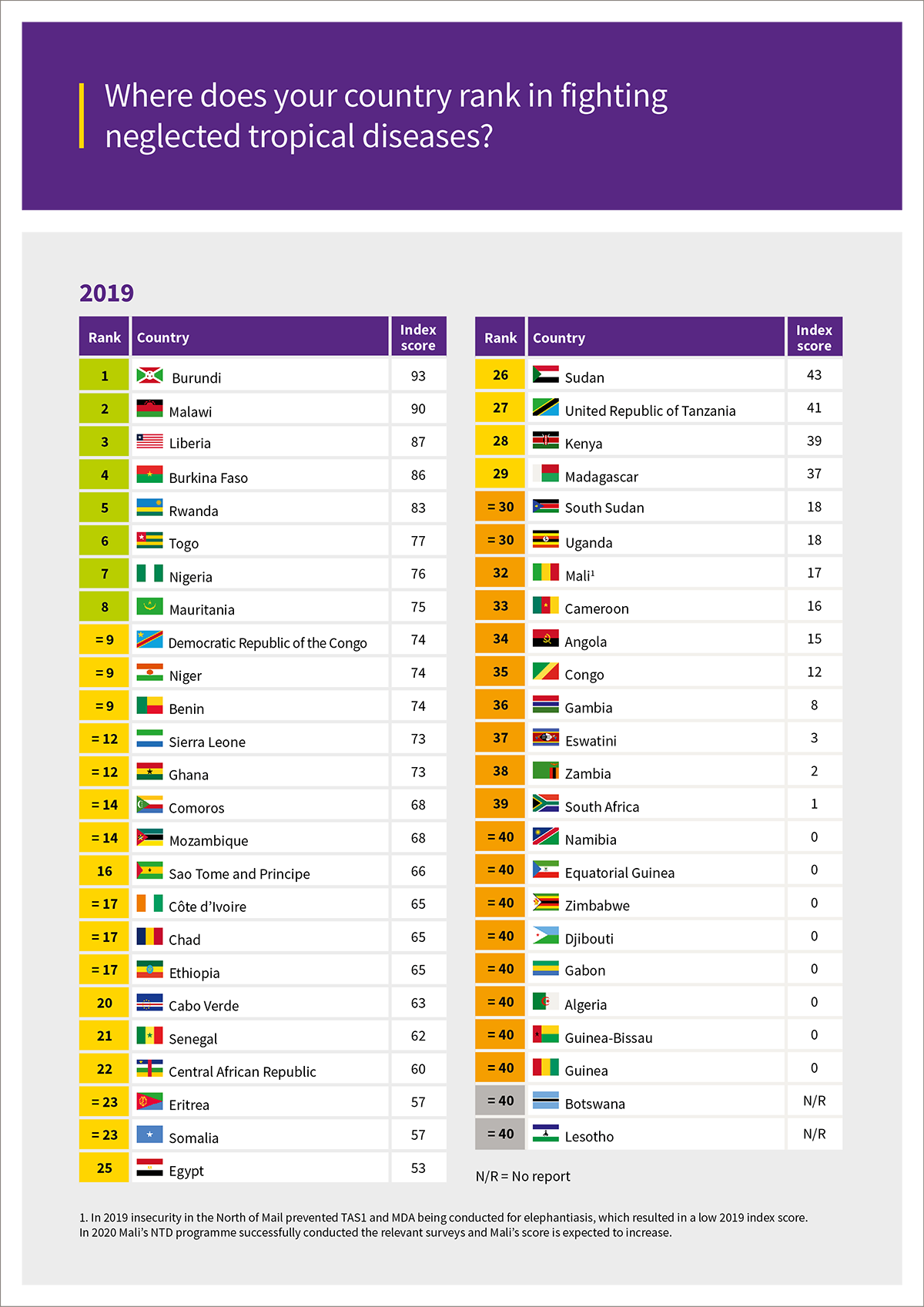
The latest data for 2019 shows that countries in Africa are doing well in the fight to beat NTDs. Huge progress has been made. But are we beating NTDs fast enough to reach the Sustainable Development Goals by 2030?
What is the Africa NTD league table?
Every year, during the African Union, the heads of states of African nations review the progress that has been made in the fight against neglected tropical diseases (NTDs) as part of the African Leaders’ Malaria Alliance (ALMA) forum. They rely on the World Health Organization’s (WHO) latest data on NTDs, which is provided by the countries themselves.
The data provided shows whether African countries are delivering treatments for the five most common NTDs, which are those that are amenable to preventive chemotherapy (PC) treatment. Those NTDs are: bilharzia, intestinal worms, lymphatic filariasis, trachoma, and river blindness. Collectively, these five NTDs continue to affect 612 million people across Africa.
What does the 2019 data tell us about the fight to beat NTDs?
The 2019 data shows progress has been made throughout Africa.
In 2015, there were 630 million people in need of treatment for at least one NTD in Africa. By 2019, this number had decreased to 612 million people, representing 18 million people whose lives are no longer affected by NTDs. The message is loud and clear: The number of NTD cases in Africa is going down and preventive treatments for NTDs are effective.
Simultaneously, the number of people receiving preventive treatments is going up. In 2015, of the 630 million people who required treatment for at least one NTD, a little over half received it. In 2019, of the 612 million people who required treatment for at least one NTD, 390 million – or 64% – benefited from treatment.
Again this tells a clear picture: NTD cases in Africa are going down, while the number of people receiving preventive treatments are going up.
It is also encouraging that progress is distributed throughout Africa, rather than being contained to a handful of countries. In 2015, only three countries – Malawi, Sierra Leone and Togo – had an index score greater than 75. But, by 2019, that number increased to eight countries.
As well as focusing on the progress that countries across Africa are making, the 2019 data also shows the progress that is being made in fighting specific NTDs.
There has been impressive progress throughout Africa, for example, in the number of people receiving treatment for schistosomiasis. Schistosomiasis (also known as bilharzia) affects 237 million people around the world, with 95% of school aged children requiring preventive treatment live in Africa.
Similarly, there has been progress across Africa in the number of people receiving treatment for trachoma: 31% of people in need of preventive treatment were receiving it in 2015; whereas 63% of those in need across Africa received preventive treatment in 2019.

But is progress happening quickly enough?
The Sustainable Development Goals (SDGs) include a target for a 90% reduction in: “The number of people requiring treatment and care for any one of the neglected tropical diseases (NTDs) targeted by the WHO NTD Roadmap and World Health Assembly resolutions and reported to WHO.”
Overall the 2019 data from Africa shows continued progress in the fight to beat NTDs. But is progress happening quickly enough to reach that SDG target by 2030? If efforts to beat NTDs continue at the current rate, while impressive and significant progress has been made, it is unlikely that the 2030 goal will be reached.
Another question is whether treatment is consistent enough every year. The peak in the number of people receiving was in 2017 (when 70% of people who required treatment for at least one NTD in Africa received that treatment) and has not been repeated since. What’s more, it’s unlikely that this figure will be sustained in 2020 due to the disruptions caused by the COVID-19 pandemic.
It’s important for countries to allocate consistent and sustained resources to treat NTDs to avoid drugs expiring due to a lack of resources. 36% of countries surveyed by Expanded Special Project for Elimination of Neglected Tropical Diseases (ESPEN) in 2020 reported that drugs were either expiring or had expired in their countries. This data was presented during an African Union webinar on 22 September 2020.
It’s clear that there are concerns and hurdles to achieving the SDG target of a 90% reduction in NTDs by 2030, and the WHO road map acknowledges this: “Much work will be required during the next decade to reach at least 1.76 billion people who still require interventions against NTDs. These diseases of poverty must be overcome in order to deliver on the SDGs and ensure universal health coverage.”
One way in which efforts to beat NTDs can be improved is through multi-sectoral collaborations. To reach road map targets and increase efforts to beat NTDs, partners will need to work with new, ‘non traditional’ stakeholders and organisations, such as those in the vector control, water and sanitation, education, infrastructure and disability sectors, to name just a few.
It is evident that multi-sectoral collaboration is beneficial for NTD programmes and that investing in NTDs can benefit other sectors, including those inside and outside of the traditional health sector. And there are multiple benefits, from strengthening primary health care, to increasing educational attainment, to economic benefits and boosting human capital.
Put simply, while progress has been made across Africa, the partnership to beat NTDs will need to diversify and expand if we are to reach the SDG target by 2030.
Years of hard work is paying off
Both Malawi and Togo have successfully eliminated an NTD in 2020.
Malawi eliminated lymphatic filariasis which, in 2013, affected 15 million people throughout the country. Lymphatic filariasis (also known as elephantiasis) is a disease that is transmitted by mosquitoes and which damages the human lymphatic system. The disease can cause severe swelling of the lower limbs. Up to 36 million people are estimated to be living with a chronic condition relating to lymphatic filariasis and 859.5 million people are thought to be at risk of the disease.
The successful elimination of lymphatic filariasis is a monumental achievement for Malawi and the Uniting to Combat NTDs partnership congratulates everyone for their hard work and dedication in reaching this milestone.
Likewise, Togo eliminated sleeping sickness in 2019, an NTD which is endemic in 35 countries in sub-Saharan Africa.
Sleeping sickness (also known as human African trypanosomiasis) is caused by an infection, with parasites transmitted to humans via the bites of infected tsetse flies. Without diagnosis and treatment, sleeping sickness is almost always fatal.
The Uniting to Combat NTDs partnership congratulates Togo for eliminating sleeping sickness – this too is an incredible achievement that will have huge benefits to people’s lives.
How the Index is calculated
The NTD coverage index is founded on the principle of equity and can be used to measure progress towards universal health coverage.
The number of people who need treatment for these five NTDs is compared with the number who receive treatment. This gives the coverage for each disease. This coverage is then averaged out using a statistical tool called ‘the geometric mean’, which gives an overall picture of how well countries are delivering an integrated programme of treatments for all the diseases.
The geometric mean shows performance across the board and does not mask poor performance of any single disease. Use of the geometric mean increases the sensitivity of the index to very low coverage rates among individual disease interventions.
Indicators on the index are ranked based on a “traffic light” system, whereby green indicates that a target is on track; yellow indicates progress has been made but more effort is required; red indicates a country is not on track; and grey is used to show an absence of data from a particular country.
Why is the table important and why does it only focus on Africa?
The league table is a helpful guide to showing how well African countries are doing in the fight to beat NTDs. It helps to both highlight achievements and show where attention needs to be focused and sustained.
More than one third of the 1.7 billion people affected by NTDs are in Africa. NTDs have a profound effect on these people’s lives as they cause immeasurable suffering: they debilitate, disfigure and can be fatal. They prevent people from being able to work, go to school and provide for their families and, in doing so, cost developing nations billions of dollars every year. It is for these reasons that the ALMA forum meets to focus on the progress made in Africa.